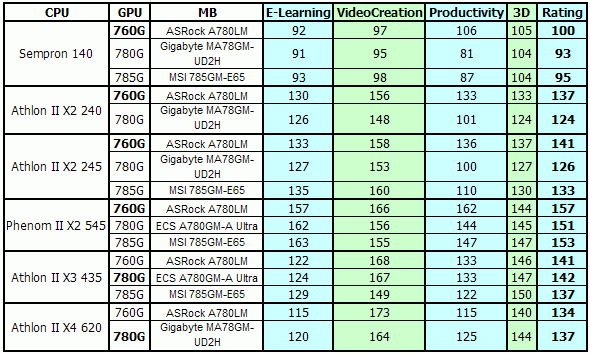This time we have taken motherboards with different chipsets for additional tests. We want to find out whether chipsets for office computers really provide higher results. In case of the AMD platform, it's the 760G.
And the differences we found were even more noticeable than we could expect. According to SYSMark 2007, this very chipset in combination with the most powerful dual-core processors provides the best results as an office platform.
It must be noted here that these differences have nothing to do with intrinsic performance of graphics cores, which differs significantly in these chipsets. As GPU power implies 3D graphics (mostly in games, the 785G is definitely the leader here, and our tests illustrate this statement). In the previous part of our tests we actually found out that SYSMark 2007 tests were absolutely indifferent to graphics cards. We tested powerful graphics cards, which are not usually used in office PCs, and then we installed them on the motherboard used for tests with integrated graphics. Results were practically identical in all cases.
Here is a possible explanation: multimedia chipsets (recommended for home computers) may be configured for maximum efficiency of data exchange between a GPU and memory. Which in its turn has a negative effect on some computational tasks. And the 760G is optimized for maximum performance of computational tasks. Don't take it literally though: you will hardly notice any performance differences in usual office applications, which could be attributed to the chipset influence. However, we have one practical conclusion: when you compare test results obtained in SYSMark 2007, you must take into account a given platform (that is processor and motherboard). And from the practical point of view, this phenomenon plays into hands of office PC manufacturers, as motherboards based on the AMD 760G are cheaper.
You can use our interactive configurator to compare PC configurations.
Conclusions
First of all we should mention that with the line of dual-core Athlons II expanded, AMD processors have become more attractive in the entry-level and Mid-End segments. This is important, when you choose a processor for the office platform, where the most popular models cost below $100.
Athlon II X3 products with three cores may also be interesting offers here. The fact is, even demonstrating no advantages in tests or programs, which cannot use more than two cores, such processors can make a computer more responsive to user's commands. Unlike the testbed, a real working environment usually includes background utilities running simultaneously with user's programs. For example, we cannot imagine a safe computer without an antivirus. System services may also load a CPU quite significantly sometimes. In such cases an extra core provides stable response of a computer without unpredictable slow downs (from the point of view of common users).
What concerns our additional analysis, we can formulate another practical recommendation. If what you need to compare is processors, not platforms, and you have only a couple of results in SYSMark 2007 obtained on several motherboards, you can do it by ignoring the Productivity test. Your comparison will be only approximative, of course. On the other hand, common sense dictates to compare platforms. A processor itself cannot demonstrate any results, if it's not installed into a motherboard (with a certain chipset, etc.) So it would have been strange not to take its influence into account regardless of its nature.
Write a comment below. No registration needed!

